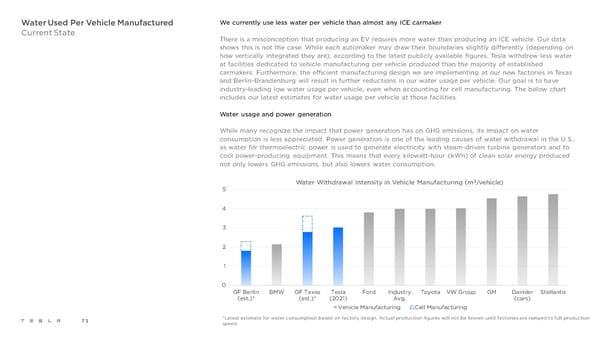Water Used Per Vehicle Manufactured We currently use less water per vehicle than almost any ICE carmaker Current State There is a misconception that producing an EV requires more water than producing an ICE vehicle. Our data shows this is not the case. While each automaker may draw their boundaries slightly differently (depending on how vertically integrated they are), according to the latest publicly available figures, Tesla withdrew less water at facilities dedicated to vehicle manufacturing per vehicle produced than the majority of established carmakers. Furthermore, the efficient manufacturing design we are implementing at our new factories in Texas and Berlin-Brandenburg will result in further reductions in our water usage per vehicle. Our goal is to have industry-leading low water usage per vehicle, even when accounting for cell manufacturing. The below chart includes our latest estimates for water usage per vehicle at those facilities. Water usage and power generation While many recognize the impact that power generation has on GHG emissions, its impact on water consumption is less appreciated. Power generation is one of the leading causes of water withdrawal in the U.S., as water for thermoelectric power is used to generate electricity with steam-driven turbine generators and to cool power-producing equipment. This means that every kilowatt-hour (kWh) of clean solar energy produced not only lowers GHG emissions, but also lowers water consumption. 3 Water Withdrawal Intensity in Vehicle Manufacturing (m /vehicle) 5 4 3 2 1 0 GF Berlin BMW GF Texas Tesla Ford Industry Toyota VW Group GM Daimler Stellantis (est.)* (est.)* (2021) Avg. (cars) Vehicle Manufacturing Cell Manufacturing 73 *Latest estimate for water consumption based on factory design. Actual production figures will not be known until factories are ramped to full production speed.
 Tesla 2021 Impact Report Page 72 Page 74
Tesla 2021 Impact Report Page 72 Page 74